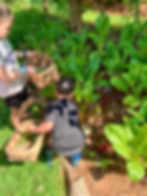5 Beginner Gardening Tips: Mistakes to Avoid for a Thriving Garden
- Allie Correa
- Aug 12
- 3 min read
Starting a garden is exciting. It’s hopeful, intentional, and filled with the promise of fresh herbs, sun-warmed tomatoes, and a deeper connection to nature. But for beginners, that excitement can quickly turn to frustration when things don’t go as planned. At Arrows Farm, we our selves have seen failures and learned lessons each season. We have seen plenty of first-time gardeners get discouraged—not because they lacked the green thumb, but because they weren’t set up for success.
The good news? These common gardening missteps are easy to avoid once you know what to look for. Here are five beginner gardening tips that will save you time, money, and heartache—and help you grow with confidence this season.

1. Planting in the Wrong Spot
The Mistake: Choosing a garden spot without observing sunlight, drainage, or airflow.
Why It Matters: Most vegetables need at least 6–8 hours of direct sun each day. Without it, growth is stunted and fruiting plants (like tomatoes or peppers) will struggle to produce. If the soil doesn't drain well, roots can rot. Poor airflow can lead to fungal diseases.
How to Avoid It: Spend a day observing your yard or space. Track where the sun hits and for how long. Avoid low spots where water collects. If you’re working with limited space, containers on a sunny porch or balcony can be a great alternative.
Tip: Raised beds or containers allow better control over soil and drainage—perfect for new gardeners!

2. Ignoring Soil Health
The Mistake: Assuming all soil is created equal.
Why It Matters: Healthy plants start with healthy soil. Many new gardeners plant directly into native soil without knowing its structure, pH, or nutrient content. Poor soil means weak plants that are more vulnerable to disease and pests.
How to Avoid It: Start with a basic soil test. Your local extension office often provides kits or testing services. You’ll learn your soil’s pH and what nutrients might be missing. From there, amend your soil with compost, aged manure, or organic matter to improve fertility and texture.
Tip: We use compost made from plant waste and leaf mulch to boost our soil naturally. You can do the same, even on a small scale!

3. Overcrowding Your Plants
The Mistake: Planting too many seeds or seedlings too close together.
Why It Matters: While it might seem like a great way to maximize space, overcrowding creates competition for sunlight, water, and nutrients. It also prevents airflow, which encourages mold, mildew, and disease.
How to Avoid It: Read the seed packet or plant tag carefully. It tells you exactly how far apart to space your plants. It might feel like you’re leaving a lot of room at first, but your garden will fill in faster than you think.
Tip: Use the square foot gardening method for a tidy, efficient layout. It helps beginners space things correctly without guessing.
4. Watering Inconsistently
The Mistake: Overwatering, underwatering, or watering at the wrong time of day.
Why It Matters: Water is crucial—but more isn’t always better. Overwatering can suffocate roots and encourage root rot. Underwatering leads to stressed, stunted plants. Watering during the heat of day causes evaporation loss.
How to Avoid It: Check soil moisture before watering. Stick your finger into the soil about 2 inches deep—if it feels dry, water thoroughly. The best time to water is early morning or late evening when temps are cooler.
Tip: Mulch around your plants to retain moisture and reduce watering needs. It’s a simple trick that makes a big difference.

5. Expecting Perfection (and Getting Discouraged When It Doesn’t Happen)
The Mistake: Giving up after a few things go wrong.
Why It Matters: Gardening is a learning process. Pests happen. Plants sometimes fail. Weather is unpredictable. New gardeners often feel like a failure if every seed doesn’t sprout or their tomatoes get blight.
How to Avoid It: Shift your mindset from perfection to progress. Every season teaches you something new and something to change for the next season. Focus on what worked and make small improvements each time.
Tip: Keep a garden journal! Track what you plant, when you plant it, and what worked (or didn’t). It’s one of the best tools for learning.
Grow With Confidence
Starting a garden isn’t just about growing food—it’s connecting you to your food source, appreciating the changes of seasons, and spending time outside. Whether you’re working with a single pot of herbs or dreaming of a full backyard plot, you’re already doing something powerful. Mistakes will happen, and that’s okay. You’re learning, growing, and becoming part of a rhythm much bigger than yourself.
At Arrows Farm, we believe everyone can grow something meaningful. Have a question about starting your own garden or want to join us for a hands-on garden day? Reach out or follow us @thearrowsfarm for more beginner gardening tips and behind-the-scenes life on the farm.
